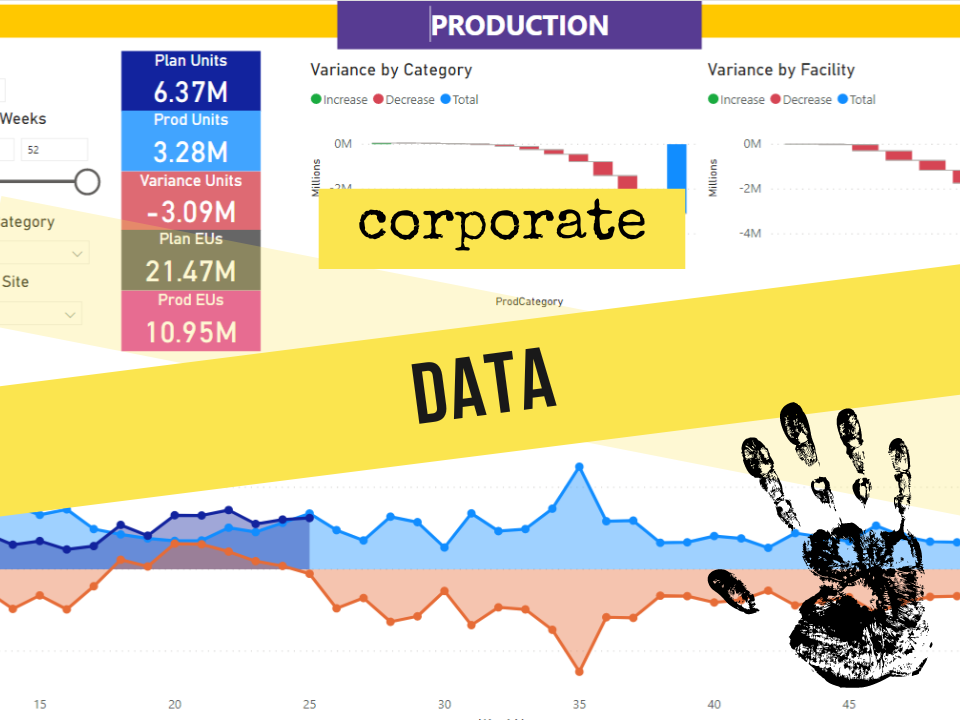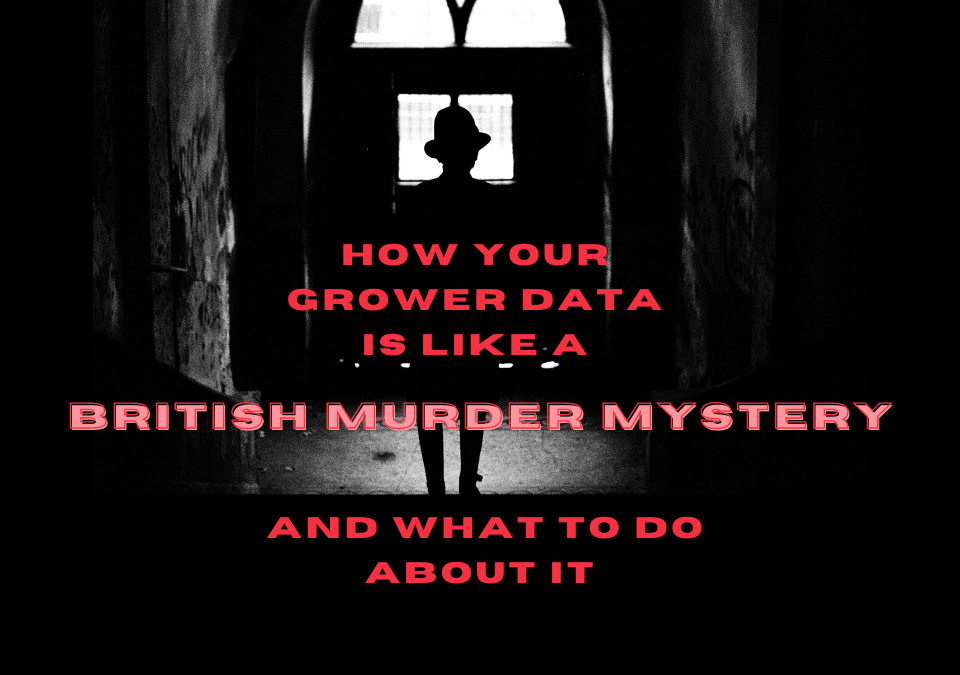
Are You Curious About How ChatGPT Could Improve Your Grower Business?
February 7, 2023
What Does ‘Cloud’ Really Mean And Why Growers Should Care?
March 20, 2023I don’t watch much TV but when I do I like a good British murder mystery. I enjoy the geniality of historic British culture juxtaposed against some heinous crime and the multilayered, iterative process of exposing the truth.
When the investigator surveys the crime scene there are the facts observable at the location, and the questions implied by what is found there. The investigator must separate the irrelevant from the relevant and, using deduction, fill in the gaps to create hypothesis that can be tested.
Corporate data is much the same in many cases. When you look at a database table or a spreadsheet there are the facts observable in the rows you see but there are also the many questions implied by what is found there.
In many systems and for the many data creations of well-meaning employees the column names or table names might as well be Egyptian Hieroglyphics. Rarely is there a published data catalog with consistent naming and data quality conventions to guide implementation.
As the saying goes ‘Dead men tell no tales’ and for certain raw data in databases or spreadsheets does not communicate its genesis nor its environment.
So here are a few ways that a grower can solve their data mysteries and improve their situations for the ones that will come later.
Know The Crime Scene
The crime scene for data is the point of data entry. What happened? How much? What items were involved? Who did it? All these relevant questions set the context for the data (or mystery).
The crime scene is where the initial set of facts lie and details about the environment can be known.
When your team captures data, say for a production entry, an order pick or a sales order delivery, make sure they are capturing all data elements that are needed for key metric update, further analysis and reporting later. It is very difficult to go back and reconstruct missing values.
Growers, due to the large number of data entries for their operations, have many ‘crime scenes’.
Make sure at each point of data entry you are getting what your organization needs for the later questions you want that data to answer.

Sample Data shown for Sample Large Grower
Copyright Advanced Grower Solutions
Label the facts
In the typical movie investigation office they setup a board called a ‘link chart’ or ‘evidence board’ where they put pictures of the suspects and other artifacts that represent the relevant facts, details and assumptions of the case and attempt to show the linkages between them.
For a growers data implementing the concept of a linkage chart is usually extremely helpful in furthering building of synthetic data reports. Knowing where you data is, what is contained there and how to access can provide help in defining new reports for insight, addressing problems in dependent calculations or cross department types of data analysis.
This type of linkage chart could show the most important databases, excel spreadsheets and other data sources used in your operation. It could also contain a ‘data dictionary’ explaining what each field means and how it is created and what its units are if applicable. Having this would certainly help in the creation of new reports of the diagnosis of existing report errors.
Survey The Witnesses
In a typical murder mystery, witness interviews or interrogations make for gripping portions of the story. And, they usually reveal new facts or details that impact the case.
Your witness are you employees. Involve them in your data story. Make sure employees know and understand the reason for each data interaction and why its important.
When there are missing records, data validation errors, or transaction limit violations, work with them so they know what the system needs, what the boundaries are, and understand the ‘why’ behind the screen.
On one project we did we worked with the controller of an annual and perennial grower on some reporting and raw material receipt processing. One day the controller asked me “Why do I have a $10,000,000 variance in raw material value yesterday?”. I didn’t know the answer at that point. But It turns out, after a quick investigation, an employee had entered a raw material receipt from a purchase order and had inadvertently added three extra 0’s on the received quantity field. In the hustle and bustle of a busy greenhouse that happens especially during planting season. The ERP system they used allowed over receiving since some suppliers, especially suppliers of plugs and cuttings, tend to slightly over ship to compensate for any small loss during shipping. The record was corrected to the right amount and the variance disappeared. Mystery solved.
This small anecdote underscores the fact that clean data is a cooperative effort between the front line employees and everyone else. Frontline employees don’t always ‘consume’ the data they provide and thus there needs to be open and regular feedback to them about data quality, recurrent issues, and the huge importance to the organization of clean, accurate data.
Synthesize Across Departments
One of the most important skills an investigator brings to a mystery is the ability to synthesize across multiple fact domains or the testimony of multiple witnesses.
The real story of your data and the most impactful insights will come in the same manner. By synthesizing across departments metrics and putting the higher-level story together across different departments or key managers.
Astute growers know that having regular meetings to allow these discussions and questions to be asked and answered gives deeper insight, and forges clearing understanding of issues, and can help identify problems and opportunities earlier in the growth cycle.
And these regular interactions create the expectation that data is important and helps our business and provides the feedback for corrections needed and improvements to be implemented.
Iterate
One thing you notice in a good investigator is they will iterate as they learn new things. They will revisit the crime scene after having learned new things. They will re-interview witnesses after finding out new details. In short, they iterate. As the story unfolds and new information is revealed they go back and review and alter the hypothesis they have created.
Both in-season and off-season growers should iterate.
Review the data, discuss with your teams, and revisit key decisions. Did they work out the way you thought? If not, why? If they did, what aspects of the data, situation, or environment made it work and how can you apply that insight to other like situations? How should those insights change your planning or operational policies?
I know this sounds like work, but it is the only way to truly bake in ideas that yielded positive improvements.
The US military uses a system called the After Action Review which is a way to perform a review process to gain insight or reveal mistakes so that participants can learn and change future engagements.
Growers should integrate the concepts of an after action review in their planning, operational management and year end reviews in order to not only gain new insights but put those into consistent operational use.
Mystery Solved!
Of course, at the end of the mystery, it’s always someone you didn’t suspect or didn’t realize was a player. And the skillful investigator brilliantly concludes the mystery with a flourish as they point out the butler did it in the library with the candlestick.
For growers, due to the highly dynamic nature of our products, there is a never-ending supply of mysteries.
Having good data practices, informed employees, and good iterative review can help growers learn and improve their operations at a better rate.
AGS has been helping growers with their data story for many years. Contact us to see how we can help you improve your data story.





